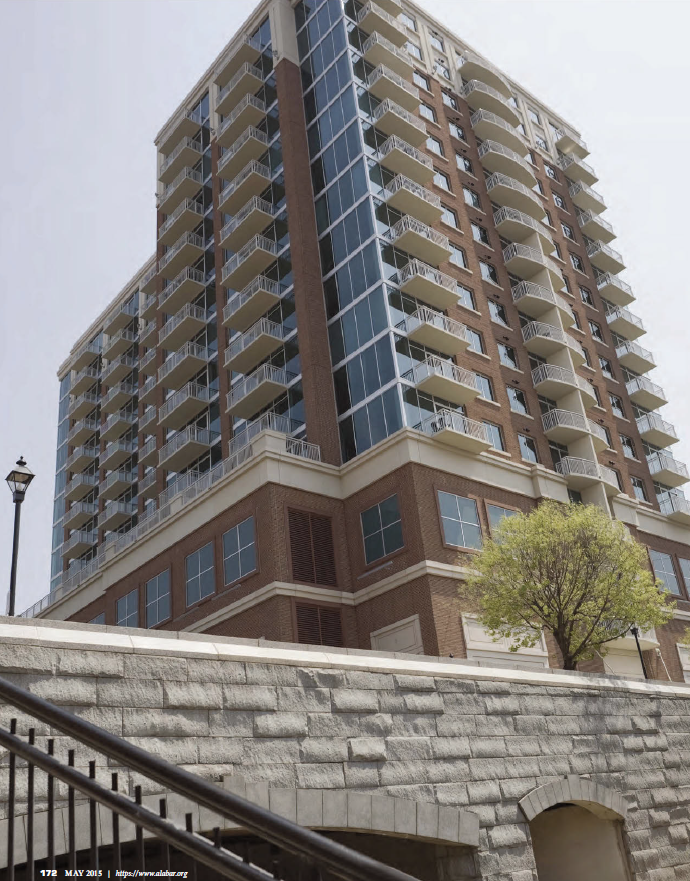The Interstate Land Sales Full Disclosure Act: the Law of Unintended Consequences as Applied to Condominiums
| Publication year | 2015 |
| Pages | 0173 |
| Citation | Vol. 76 No. 3 Pg. 0173 |

In the heyday of the robust real estate market in the first half of the 2000s, condominiums were a hot commodity for buyers, investors and speculators alike. And developers were more than eager to feed their seemingly insatiable appetite. Though south Florida was likely the epicenter of the nation's high-flying condominium market, regions across the country were not immune to the irrational exuberance, including Alabama and, particularly, the gulf coast. As the adage goes, a rising tide lifts all boats.
Bolstered by easy credit, low carrying costs (taxes, insurance, dues, etc.) and fair weather, Alabama gulf coast condominium development and sales skyrocketed. During that time, though unheard of before, it was not unusual to hear about an entire condominium being pre-sold in a single day. While other investments were flat or otherwise unappealing, condos were all the rage, and demand soared. Some likened the condo craze to a feeding frenzy in shark infested waters. Such was not an exaggeration according to this author's observations.
Speculators flooded the market, seeking, and for a while enjoying, never-before-seen returns on their condominium investments. Many opportunists signed preconstruction purchase agreements for little to no money down, with little to no intention of closing, and assigned (or "flipped") their contracts to other buyers. Many condominium units were flipped several times before the first closing to an end user after construction was completed, with each and every intermediate flipper making a profit along the way. A typical earnest money deposit was 20 percent of the purchase price, which was often supplied by issuers of letters of credit for little or no security or collateral provided by buyers. It seemed as if everybody and his brother were buying condos.
Courts, too, recognized the euphoric condition of the market at the time. A Florida U.S. District Court noted, "During the housing boom there was no hotter commodity [than a condominium unit]. At the height of frenzied buying, people stood in long lines just for a chance to put a deposit down and secure a unit. Often the unit was immediately resold, or flipped, several times for a profit."1
Alas, the euphoric market conditions could not, and did not, last. In August 2005, Hurricane Katrina made landfall on the northern gulf coast, and in addition to the unimaginable physical destruction the storm left in her wake, many believe she was the proverbial straw that broke the camel's back of the coastal real estate market. Like being splashed with a bucket of cold water, observers were doused with the reality that the market for high-end, resort-style, upscale coastal condominiums had been artificially supported by bad economics. Not surprisingly, in hindsight, the market suffered a dramatic, and emphatic, collapse in Katrina's aftermath. Demand vanished and values plummeted, as much as 50 percent in some cases. Against this backdrop, many preconstruction condominium buyers, especially flippers and other speculators, were left holding the bag, stuck with contracts and letters of credit but no resale market.
Many turned to the courts to bail them out, rescind their purchase agreements and refund their deposits. Certainly there were some legitimate claims, but many were looking for an insurance policy against the very risk they so willingly took before the market crash. The Trojan horse for developers was the Interstate Land Sales Full Disclosure Act ("ILSA"),2 a federal consumer protection statute, and as some say, a law of unintended consequences as it has been applied to condominiums. Few anticipated the rising tide of these unintended consequences during the real estate and economic boom times, and it was not until about 2008 that condo buyers and their lawyers cleverly began to press ILSA into service in litigation against condominium developers.
In 2009, the Eleventh Circuit remarked in a case originating from a Florida U.S. District Court:
In a market-based economy the price of housing, like other goods, is subject to swings. There was a sharp upward swing in housing prices between late 2000 and the end of 2005 . . . All bubbles eventually burst, as this one did. The bigger the bubble, the bigger the pop. The bigger the pop, the bigger the losses. And the bigger the losses, the more likely litigation will ensue. Hence this case . . . After the housing bubble burst, the [plaintiffs] had second thoughts about their decision to purchase the condominium unit. Wanting out of their contract, they seized on to the Interstate Land Sales Full Disclosure Act, a federal statute that has become an increasingly popular means of channeling buyer's remorse into a legal defense . . .3
Also in 2009, an Alabama U.S. District Court commented on the condominium market crash and the utilization of ILSA as a weapon that purchasers employed against developers:
This action is one of many filed in federal and state courts along the Gulf Coast in recent years involving a condominium deal gone bad. Plaintiffs . . . entered into a contract . . . in the summer of 2005 to purchase a pre-construction condominium unit . . . at a development located in Gulf Shores, Alabama. Plaintiffs' expressed intention was to flip their unit at or before closing to obtain a sizeable and immediate return on their investment. [Plaintiffs] closed on the unit in September 2007, but later came to regret that decision when the real estate market stumbled badly,...
To continue reading
Request your trial
